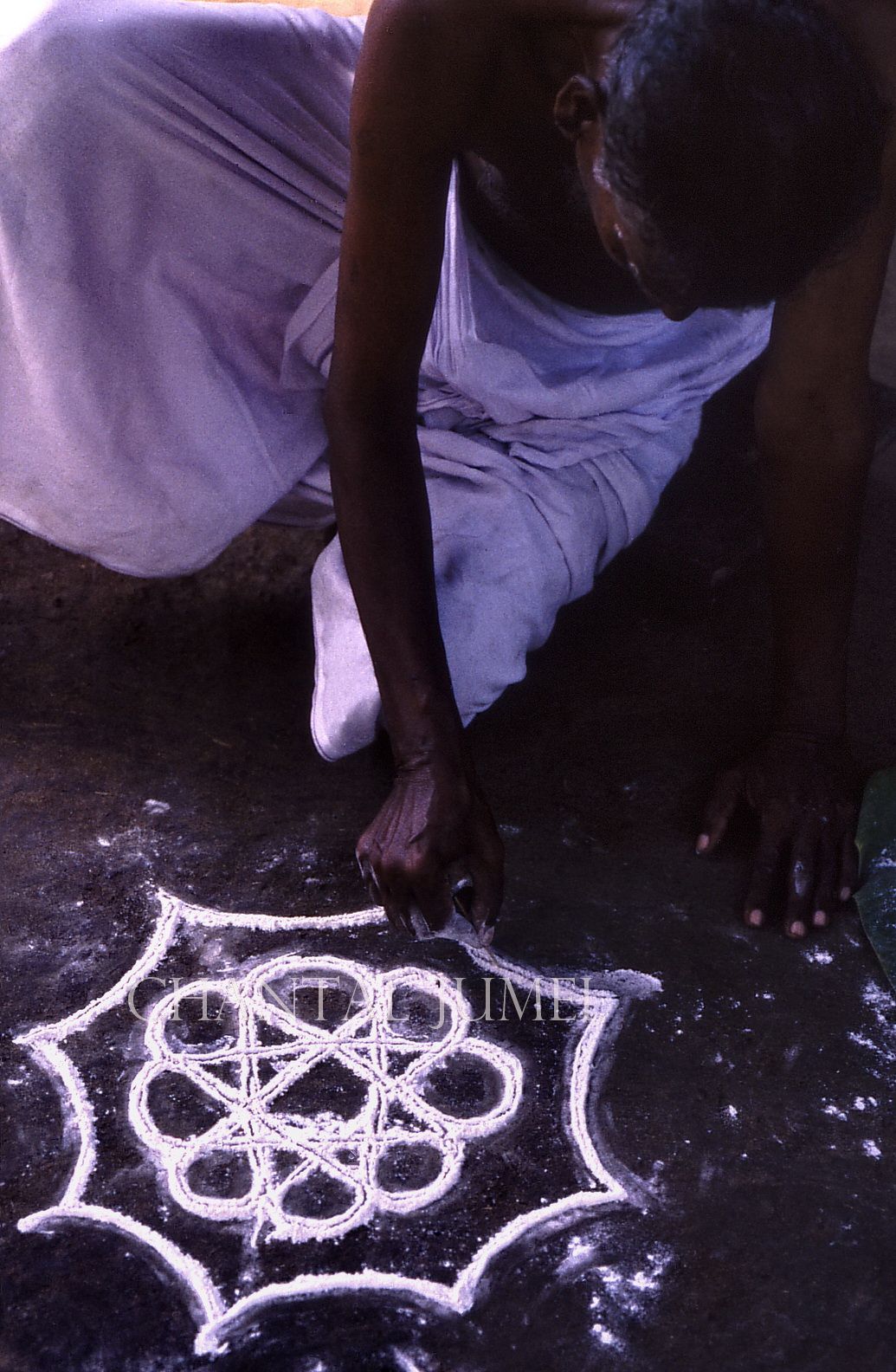Kerala Kalam, Pulluvanpattu "To protect mother and child"— part 1
Although Western medicine has long been part of the Kerala landscape, there are still communities of ritual painters whose hereditary task equates them to medicine-men. Pulluvanpattum was once an exorcism and its ceremonial paintings were designed for an essentially therapeutic purpose.

Pulluvanpattu, an exorcism
Although Western medicine has long been part of the Kerala landscape, there are still communities of ritual painters whose hereditary task equates them to medicine-men. Their ceremonial paintings are designed for an essentially therapeutic purpose and the deities invoked are those who caused the specific diseases. Here is one of many rituals related to women, fertility, infertility, menstruation, pregnancy, and children. These rituals were once in vogue in Kerala, and several are still practiced today.
Pullu, the ominous bird
Birds, their cries and their flights, have always been associated with the signs of destiny. The Atharva Veda advocates more than one charm to repel the bad influences of birds.
What this black bird flying forth towards (me) has dropped here - May the waters protect me from all misfortune and evil! What this black bird has brushed here with thy mouth, Ô Nirriti (goddess of misfortune)- may Agni (the god of the household fire) free me from this sin. A.V 7, 64
Hymns of Atharva Veda, M. Bloomfield, Sacred books of the East, Vol. 42
In Kerala, the widespread fear was the pullu, a bird of the owl family. It was once thought that it was enough for this bird to fly over a pregnant woman to affect the unborn child with acute diarrhoea that could lead to death. The child, like the bird, would curl up and his plaintive cries would resemble those of the latter.

Pulluvanpattu, completely fallen into disuse, was once performed to annihilate or repel the bad influences of the pullu bird. This exorcism took place in the home of the suffering child or pregnant woman who was convinced to have seen the ominous bird flying above her head.

The Pulluvan who conduct this rite belong to a different section of the Pulluvan mentioned in my previous articles on snake worship in Kerala. There are two groups among them: the nâgam padi who conduct the rites for the Nâga, and the pretam padi who cast away evil entities. In this case, the Pulluvan of the district of Kasaragod (north of Kerala) are astrologers and medicine-men because they have the reputation of curing the ailments of pregnant women. They belong to the castes of inferior status, worship the Brahmanical gods, and believe in various spirits. They also practice magic and sorcery, and sacrifice goats and lambs to quell the demons who prey on pregnant women and young children.
Painting the kalam
For the purpose of my research, the Pulluvan officiants agreed to draw the geometric diagrams that once accompanied the ritual. The first drawing is called "ashtadelam" (which has eight petals) and the other "sudarshana chakram". One of the Pulluvan sketched the eight-petal diagram with powdered lime or chunnam. This coarsely ground material is used to ward off evil spirits, while rice flour is destined for auspicious rituals.

Meanwhile, the eldest man sprinkled black powder on a circular area. Then, he traced several circles using the pierced spathe of an Areca palm (Areca catechu) filled with lime powder.


Once the “ashtadelam” sketch was completed, the officiant added turmeric and red for the centre and grey on the periphery while the eight petals alternated the two colours.

Sudarshana chakram consists of two superimposed squares. Four coloured birds parading impudently on the apexes of one of the quadrilaterals symbolize the entities invoked during the ritual. Sudarshana is also the spinning disk-like weapon of Vishnu used for the destruction of evil and enemies. The healers, fearing the loss of their magical powers, did not disclose the sacred formulas and the symbolism of the forms and colours of the kalam.




Offerings and songs to drive away the bird
The Pulluvan invoke, through their propitiatory songs, Ganesha and Goddess Sarasvati. Dhanvantari, the God of medicine and Ayurveda, born from the churning of the Ocean of Milk and carrying the cup of Amrita (ambrosia), is also supplicated. Indra, the king of the gods, taught Dhanvantari the art of medicine. There are few temples whose divinity evokes the spirit of Dhanvantari. The temple of Maruthorvattam in Alappuzha (south of Kerala) is one among them, and the main offering is a dish made of plants supposed to cure stomach aches (bloating, gas). After the appropriate offerings, the eldest Pulluvan, accompanied by a kutam (a clay pot with a mono string played with a plectrum) and vîna (one-stringed fiddle), sings the origin and deeds of the Pulluvan community.

For the duration of the songs, the child or the pregnant woman is seated near the kalam. The ceremony ends by giving the child the remedies that include an oil to strengthen his body, as well as a powder for internal use. The coloured dust of the two kalam, mixed with dried cow dung are placed at the foot of a tree as in every exorcism.
The article is a translated excerpt from my book : "Kolam et Kalam, peintures rituelles éphémères de l'Inde du Sud", Editions Geuthner, Paris 2010.
